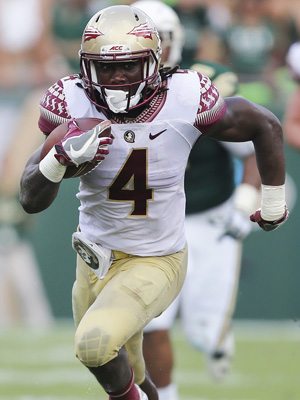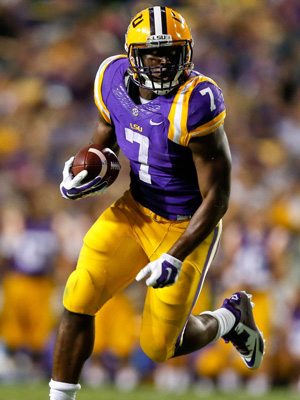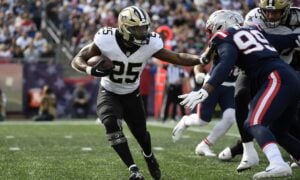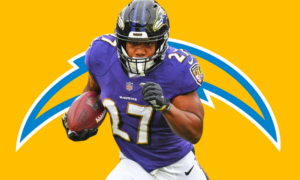Dynasty Debate: Dalvin Cook vs Leonard Fournette
The 2017 running back class could rival the class of 2015 in the amount of potential starters who emerge from it. At the top of this year’s list are LSU’s Leonard Fournette and Florida State’s Dalvin Cook. There was a time when running backs were the lifeblood of NFL offenses. Now, Fournette and Cook are trying to become just the fourth and fifth running backs selected in the first round since 2012.
The recent success of players like Le’Veon Bell and last year’s number four overall pick Ezekiel Elliott, combined with the dominance of the Atlanta Falcon’s two-headed rushing attack and the meteoric ascension of late round picks like David Johnson, Jordan Howard, and Jay Ajayi could all be factors which lead teams to re-prioritize the running back position. Fournette and Cook lead this year’s class due to their tremendous upside and game-changing ability. But which player will be the better fantasy asset to own? Mo Brewington and James Simpson will debate the merits of each, and help you draw your own conclusion.
[am4show have=’g1;’ guest_error=’sub_message’ user_error=’sub_message’ ]
Mo’s Argument for Dalvin Cook
Dalvin Cook has been Florida State’s leading rusher since coming to Tallahassee in 2014. He spent that freshman season in a timeshare with Karlos Williams, out-rushing the senior by 319 yards, despite handling 20 fewer carries on the year. Cook broke the school’s career rushing record in just three seasons, surpassing Warrick Dunn (who played four years) and Devonta Freeman, in the process.
If you’re looking for evidence that Cook can be a true workhorse at the next level, look no further than the way he’s carried the Seminoles’ offense in the two seasons since Jameis Winston left for the NFL. He rushed for 100 yards or more in 17 of the 25 games played over that span, scoring touchdowns in 21 of those contests. Cook compiled over 1,000 yards in each of his three years at FSU, racking up 1,691 yards and 19 touchdowns as a sophomore, and following that with a 1,765 yard, 19-touchdown campaign in 2016.
At 5’11” tall, Cook came to FSU weighing less than 200 pounds, before bulking up to roughly 215 lbs. Dalvin has an opportunity to become the third running back taken in the top ten over the last three drafts, joining Todd Gurley and Ezekiel Elliott. He’s a different style of runner than either of those backs, yet he’s certain to draw comparisons to the Cowboys’ rookie in particular, as analysts look to establish how Cook’s ability translates to the NFL. Examining their sophomore and junior seasons reveals that Cook’s usage and production were surprisingly similar to Elliott’s at Ohio State.
Elliott versus Cook (Sophomore and Junior Season Combined Totals)
Ezekiel Elliott: 562 carries / 3,699 yards / 41 TDs / 6.58 YPC and 55 receptions / 426 receiving yards / 0 TDs / 7.7 YPR
Dalvin Cook: 517 carries / 3,456 yards / 38 TDs / 6.68 YPC and 57 receptions / 732 receiving yards / 2 TDs / 12.8 YPR
Zeke’s rushing totals at OSU were off the charts, outpacing Cook by 243 yards on 45 more attempts. Yet, Dalvin actually averaged one-tenth of a yard more per carry. Cook makes up for Zeke’s rushing edge in the passing game, totalling 306 more receiving yards on just two extra receptions, and out-gaining Elliott by a staggering 5.1 yards per catch.
In his final season in Tallahassee, Dalvin gained 50 or more receiving yards five times, including two 100-yard efforts through the air. Elliott had just two 50-yard receiving days over his entire collegiate career. In total, Dalvin Cook racked up 4,188 yards from scrimmage over his sophomore and junior seasons. Zeke Elliott totalled 4,125 scrimmage yards over the same time frame. On a per-touch basis, that amounts to 7.3 yards per touch for Cook, compared to just 6.7 YPT for Elliott. Zeke did at least manage to score one more touchdown.
Seeing how well his numbers stack-up to the “soon-to-be-NFL Rookie of the Year” gives some perspective on Dalvin’s upside. Especially encouraging is the fact Cook hasn’t scratched the surface of his potential in the passing game. The Seminoles’ offense relied heavily on zone-read concepts, to make up for a lackluster air attack. There’s no telling how many explosive plays he’ll make at the next level in a pro-style system focused on getting him the football in space.
Yet, this debate was supposed to be between Cook and Leonard Fournette. Unfortunately, Fournette suffered a high ankle sprain this preseason which dogged him throughout his final year at LSU, making an “apples-for-apples” comparison impractical.
Fournette’s junior year, however, was a monstrous 1,953-yard showcase, with 22 trips to the end zone, and an additional 253 yards gained on 19 receptions. His receiving numbers aren’t gaudy, yet the Tigers used him enough in the passing game to prove he’s a receiving threat at every level of the defense. There is no denying that the LSU star has the look of an elite, professional running back. He’s larger than most of the linebackers he’ll encounter in the trenches, and he’s faster than most of the defensive backs who will chase from behind, in vain.
Owners trying decide which of these two future stars is worthy of their precious draft capital will have to weigh their faith in Fournette’s viability as a three-down back, along with his ability to stay healthy while taking the pounding his running style invites.
Both players can shake tacklers at will, but they do it in very differents ways. If Fournette is the proverbial, “bowling bowl of butcher knives,” then Cook is more like a “basketball, outfitted with bayonets and covered in butter” based on his uncanny knack for escaping tackles. When he’s not running through would-be tacklers, he’s consistently beating defenders to the edge and sifting his way through traffic, waiting to explode once a lane presents itself.
Dalvin Cook’s game is loaded with traits which make players indispensable at the next level. Perhaps the biggest of which is his knack for making plays when his team is behind on the scoreboard. Consider the following excerpt, written by Pedro Moura of the Orange County Register, from the run up to the 2015 Rose Bowl.
“With his team trailing this year – and the defending national champions played from behind frequently (nine of 13 games, six of their last seven) for an undefeated team – he (Cook) has carried 36 times for 344 yards (9.6 per carry), rushed for six of his eight touchdowns and had 13 runs of at least 10 yards and six of at least 20.”
Cook’s ability to rip-off chunk yardage makes him tough to take off the field. His game has no obvious deficiencies. He was criminally under-utilized as a receiver and he’s a very effective blocker as well, two skills which will bolster his claim to playing time from day one. Barring an unforeseen setback, Dalvin Cook will be one of the first 15 players picked in the upcoming draft, but realistically, he deserves to go in the top five. He should also be the first running back taken in your league’s rookie draft. Do yourself a favor, and don’t overthink a sure thing.
James’ Argument for Leonard Fournette
Once in a while, we come across freaks of nature in this league. Players whose size, speed and physical talents make them seem like men amongst boys. Leonard Fournette is one of those men, and I’ll explain why I believe he should be your 1.01.
Firstly, I know I’m clearly fighting an uphill battle against the majority here. I am by no means against Dalvin Cook. I’m not going to try and talk you out of him, because I’m a huge fan of his talent. Mo makes an excellent argument for taking him first, and he’ll be a star in this league. However, I don’t believe it’s as clear cut as many people think. The two backs are close, and my case considers that over the next two months they will get even closer. The NFL’s infatuation with Fournette’s physical capabilities will ultimately push him above Cook in the NFL Draft, and we’ll recognize him for the unique specimen he is.
His Career So Far
One of the most highly-recruited players to ever come out of Louisiana, he was the number one player in the 2014 class (for both ESPN and Scout.com). Cook was the third-ranked running back in that class (behind Sony Michel), so they’ve both dealt with high expectations throughout their careers, and they both came through with flying colors. Being a top recruit definitely doesn’t make a player a lock for NFL, or even college success, but Fournette has lived up to the hype so far.
His freshman season was stellar (187-1034-10), but he was a sensation as a sophomore, setting school records for rushing yards (1953) and touchdowns (22). He averaged over 162 rushing yards per game, and even kicked off the season with seven straight 150-yard games (going over 200 in three of the first four). He simply couldn’t be stopped. Fournette’s subpar 2016 season totals (129-843-8) have made Cook a cleare leader than he should be, but Fournette was fighting both high and low ankle sprains and a bone bruise, so we shouldn’t let it affect our view on what he is capable of.
On the Field
What positives have I noticed from watching Fournette over the past few years and his 13 Draft Breakdown videos? Well not only is he listed big, he looks big. He plays upright, and his pure power allows him to truck lighter defenders like they aren’t even there. Fournette gets upfield without hesitation, and although part of that may be to do with LSU’s ‘lead toss‘, it’s clear he doesn’t immediately think to take a trip to the corner store. He’s what many would call a ‘finisher’, barreling over and through defenders at the end of his runs (meaning he’ll be in for all goal-line opportunities), and his “get off me” attitude will force many missed tackles in the NFL, or at the very least will give a team two or three yards when they should have been stopped. Just see his 2015 contest against Auburn for an example of all of the above.
Fournette’s balance is something to behold, boasting one of the finest spin moves of this year’s running back crop. It’s also rare to see someone hurdle low-tackling defenders with such ease, but somehow he makes it a habit. Despite the height and weight, he doesn’t plod, showing quick feet and the ability to shuffle around blockers and defenders in close quarters, all the while attacking open space. Speaking of open space – while Fournette wasn’t used as a receiver a lot (41 catches in three years), but he is absurd in the screen game and showed off good mitts when given the opportunity.
 Overall, he’s true workhorse back and the type of player a team will keep pounding away with until cracks start to show in an opposition defense, and when they do, Fournette will take full advantage.
Overall, he’s true workhorse back and the type of player a team will keep pounding away with until cracks start to show in an opposition defense, and when they do, Fournette will take full advantage.
The Top ‘NFL’ Back
How much do NFL folks like him? Well, just as Mo compared Cook to Ezekiel Elliott, I’ll do the same and point you to a recent piece by Daniel Jeremiah of NFL.com in which three of five NFL execs chose Fournette as the player they would choose of the two. Jeremiah makes the point that while most people would agree Elliott is the more versatile and perhaps better all-around player, Fournette’s size and speed combination is extremely rare. As one exec put it, “he’s the most talented runner to come out since Adrian Peterson“. While I wouldn’t expect either Fournette or Cook to have the season Elliott had in their rookie campaigns, they are both capable of huge success early.
If you currently have Cook at the top spot, what would have to happen for that to change? In Jeremiah’s first mock draft, Fournette went eighth overall to Carolina, and Cook at 12 to the Browns. Is Carolina a strong enough situation for you to move the needle? Lance Zierlein’s mock sees Fournette ending up in Cleveland, and Cook falling to pick 27 and Kansas City. If Cook slides to the end of the first, would he still be regarded as a supreme talent? I am sure Fournette will be an extremely high pick, and we need to take that into account.
Addressing Concerns
There are, of course, some doubts. Firstly, he certainly had a ‘down year’ by all means, playing in only seven contests in 2016, but based solely on performance he still looked outstanding and actually matched his yards-per-carry average from his record-setting sophomore season. Just like we have opportunities to buy current NFL players in dynasty while they are injured, we should note when supreme college talents may be cheaper than usual because of their ailments. Yes, he skipped a bowl game, but I would too if I’d missed most of the year with an ankle injury and wanted to get right before the NFL Combine (Fournette said recently said that the ankle is now “doing fine” after he finally had a few weeks to let it heal).
One case that can often be made against players who are ‘big and strong’ is that they rely on these traits over ‘football’ ability. We talk about size and speed so much that there’s more chance of growing visually infatuated by them than by patience and vision, right? If you put Fournette and Le’Veon Bell side by side, it’s clear who would look the most impressive, but among 22 moving bodies, who would display the best ability to understand the right moves to make and where to be (the answer is Bell, clearly)? Size and speed don’t always win out, but Fournette is not a bull in a China shop who simply runs straight ahead with his head down (think Christine Michael). He’s so much more, and to picture a time when he refines his game even further to best utilize his astonishing physical traits, I get giddy.
Also, it’s clear he had his worst games against the toughest competition (Alabama), but thankfully he won’t have to play Alabama ever again. Problem solved.
In Dynasty Football
We love highlight-reel players and physical beasts, so in terms of dynasty value and trade price, Fournette will be one of the most highly-coveted players from the moment he’s drafted through to at least the beginning of his sophomore year. All it will take is a couple of huge plays and there’s a chance he even cracks the first round in startups once he is thrust into a full-time starting role. Last year, when the rookies entered our ADP for the first time, the top player (Laquon Treadwell) came in a 26th overall, but after the NFL Draft, top rookie Elliot was all the way up at 17. While neither of the backs discussed here can end up in a situation as good as Zeke, they both have the potential to slot straight into our first two rounds given the right landing spots.
He’s big, he’s fast, and he’ll blow you away on the football field. Take Leonard Fournette with your 1.01, and don’t look back (when he’s flying past NFL defenders, he sure won’t).
Who is your choice for the 1.01? Who provided the most convincing argument? What would have to happen for you to change your mind? Be sure to let us know in the comments section.
[/am4show]
- 2022 Rookie Class: An Early Look at Kenny Pickett, QB Pittsburgh - January 31, 2022
- Dynasty Fantasy Football Rookie Update: Quez Watkins, WR PHI - July 15, 2020
- Dynasty Fantasy Football Rookie Update: John Hightower, WR PHI - July 7, 2020

































































